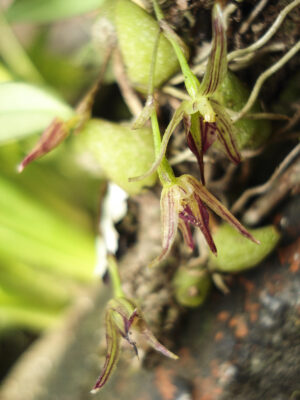He identified over a dozen new orchid species
Originally published on Global Voices

Bhakta Bahadur Raskoti studying orchids. Image via Bhakta Bahadur Raskoti. Used with permission.
Orchids, a beautiful species of flowering plants, are one of the most traded flowers in the world. Nepal is home to more than 500 varieties of wild orchids. But some of these rare flowers are under threat, as every year, smugglers illegally export thousands of flowers from Nepal. While many orchid species are disappearing due to illegal trading and unsustainable harvesting, conservationists and researchers like Bhakta Bahadur Raskoti are on a mission to document and conserve the remaining orchids of Nepal.
Raskoti was raised in a farming family in the remote Pokharathok Village, located in the Arghakhanchi District of Western Nepal. During his daily four-hour trek to school and back, he would admire the beautiful orchids in the forest on his route. This encounter with the flowers eventually inspired him to pursue a career as an orchid expert and researcher.
Read More: Threats to Nepal’s endangered orchids
Upon enrolling in college, Raskoti became aware of the ecological significance of orchids and began to document them. As a result of his efforts, he has authored several books, including “Orchids of Nepal,” “Medicinal Orchids of Nepal,” and “Himalayan Flowers of Nepal.” In addition, he has identified a dozen new species of orchids native to Nepal that were previously unknown.
Sanjib Chaudhary from Global Voices caught up with Raskoti to talk about his journey from a Nepalese boy admiring orchids on his way to school to an internationally renowned orchid expert and researcher.
Global Voices (GV): Can you please share with us about the new species of orchids you discovered in Nepal?

Bulbophyllum raskotii (Basonym Sunipia nepalensis). Image by Bhakta Bahadur Raskoti. Used with permission.
Bhakta Bahadur Raskoti (BBR): During two decades of my research and documentation, I have found more than a dozen orchid species new to science, about 100 new species records for Nepal, and a new species of genus Impatiens.
I came across the first new species in Daman of Central Nepal in 2009 and since then have continued collecting and documenting orchids from throughout Nepal. I have dedicated the new species to conservationists including the new Impatiens species to Nirmal Purja, the renowned mountaineer who climbed 14 highest peaks in the world in record time, as he has been raising voice for climate action.
GV: How did you get into documenting orchids?
BBR: I was always fascinated by orchids. While going to school in my remote village, I would see orchids on the way. After getting enrolled in college, I learnt more about the orchids and their importance. They were the same orchids that I used to see in the jungle during my school days. I went back to the same place but noticed that the abundantly found orchids were on the decline due to felling of trees and grazing.
Realising the importance of conserving the orchids, I set out on a journey to document the orchids found in Nepal. However, there was not enough published literature on orchids from Nepal. Then I bought a camera and started documenting orchids from across Nepal.
During the Maoist insurgency [also known as the Nepalese Civil War] it was difficult to travel and document orchids — [there was threat] both from the security and Maoist forces. However, I kept on documenting the orchids.
The book ‘Orchids of Nepal’ is my labor of love — an outcome of more than 10 years research about orchids. It details out the ecology, phenology, conservation status and cause of threats to more than 300 species and varieties of wild orchids of Nepal. I’ve also co-authored ‘Medicinal Orchids of Nepal’ and ‘Himalayan Flowers of Nepal’.

Neottia chandrae from Central Nepal. Image by Bhakta Bahadur Raskoti. Used with permission.
GV: What motivates you to do what you do?
BBR: If you have a passion for a certain thing, it pushes and motivates you all the time. It’s also about self satisfaction — the journal articles published about the discoveries and the recognition fuels my motivation. I was also awarded WWF’s Abraham Conservation Awards in 2010 for my documentation and research about orchids.
GV: What are the challenges to orchid conservation in Nepal?
BBR: The major challenge is illegal trade which still persists. However, more than that, the destruction caused by bulldozer development, the making of roads everywhere without proper planning. It's more devastating than trade. The illegal trade is a bit more controlled than earlier.
GV: What are the hotspots of orchids in Nepal?
BBR: The major hotspots of orchids in Nepal are Panchase, Daman and Ilam. A wide variety of orchids are found in a small area in these places. Palpa is also another hotspot of orchids. Not less than 100 orchid species can be found here within an hour’s walking distance in a community based orchid sanctuary.

Habenaria sandiegoensis from Eastern Nepal. Image by Bhakta Bahadur Raskoti. Used with permission.
GV: You’ve been documenting orchids for a long time. How do you look at the future of orchids in Nepal?
BBR: Orchids grow in any type of climate and region. An orchid is a symbol of hardship. It is associated with Limbu culture and considered auspicious and important during marriage.
The awareness about orchids was almost zero at the beginning but people are more aware now. However, they still undermire orchids’ value.
It is sad to say that the traders know more about orchids than botanists and scientists in Nepal.
Post a Comment